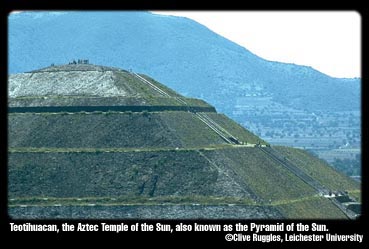|
|
|||||
|
The Dawn of Sun Science |
|
||||
 The Sun in ancient cultures The ancient Greeks believed that the sun was the chariot of the god Helios, driven across the heavens by four horses. For the ancient peoples of Peru, the Inca and the Maya, the sun was a god, and they carefully observed and recorded the changing arc that the sun inscribed in the sky throughout the year, forming detailed calendars. According to archaeoastronomer and stellar physicist David Dearborn, there is reason to believe that some Meso-American cultures recognized sunspots. |
|
|
||
| Although there is no clear evidence that the Inca or the Maya noticed sunspots, the Aztec myth of creation relates that an obscure but brave god with a scabby pock-marked face sacrificed himself by fire to become the sun, which strongly suggests that they had seen dark blemishes on the sun. |
||
According to Dearborn, it is not surprising that most ancient cultures revered the sun as a god. "The sun is a very powerful force that affects us here on earth. It gives us warmth and light, and it has the power to grow the plants that humans use as crops. After the Europeans first arrived in the Andes (South America), the Jesuit priests reported back to Europe, saying that people here believed the sun had the power to make things grow. Well, the sun DOES have the power to make things grow, plain and simple..." |
||
The Andean peoples were not alone in their attention to the sun; almost every early culture around the world, revered some form of sun god. Dearborn continues, "In early stages of development, humanity looked around itself, and wanted to understand the sun, because if they could understand things, they might avoid some problems, such as planting their crops at the wrong time." But, as Dearborn explains, "their explanations in early days was usually not that the sun was just a natural phenomenon...." |
|
|
| "...instead, they tried to understand the sun, and the rest of nature, in a human context. They assigned the sun the ... features of a god, not necessarily completely human, but a very powerful being, and that powerful being should be paid attention to, and propitiated (pleased) with offerings, so that it would continue to give people the heat and warmth and grow the crops." | ||
|
|
|||||
|
|
|||||
|
ęCopyright 2001 Regents of the University of California. |
